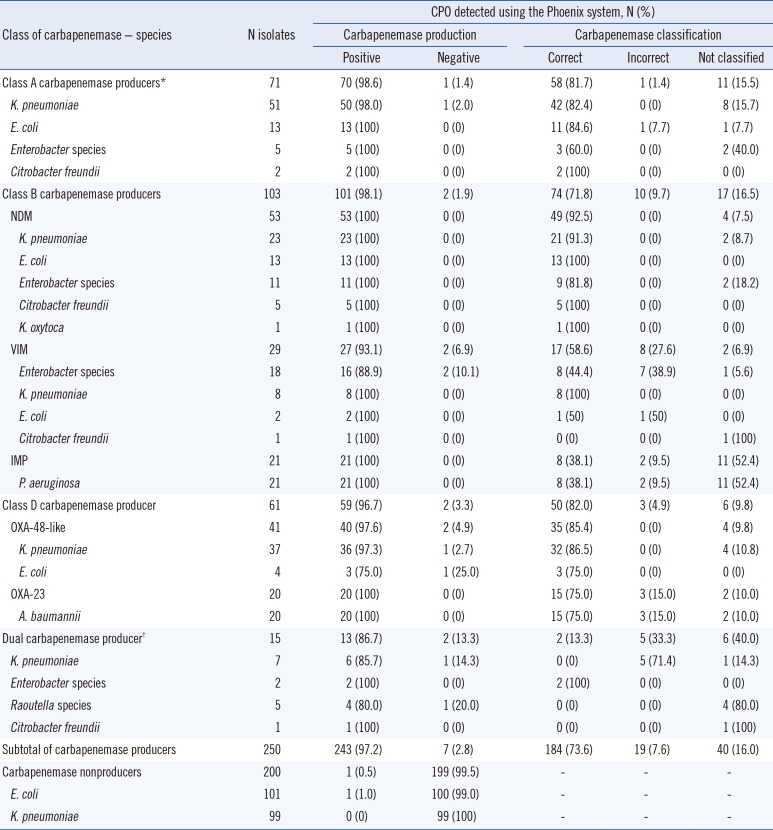1. Kallen AJ, Srinivasan A. Current epidemiology of multidrug-resistant gram-negative bacilli in the United States. Infect Control Hosp Epidemiol. 2010; 31(S1):S51–S54. PMID:
20929371.
2. Dortet L, Bréchard L, Poirel L, Nordmann P. Impact of the isolation medium for detection of carbapenemase-producing
Enterobacteriaceae using an updated version of the Carba NP test. J Med Microbiol. 2014; 63:772–776. PMID:
24591705.
3. Morrison BJ, Rubin JE. Carbapenemase producing bacteria in the food supply escaping detection. PLoS One. 2015; 10:e0126717. PMID:
25966303.
4. Rubin JE, Ekanayake S, Fernando C. Carbapenemase-producing organism in food, 2014. Emerg Infect Dis. 2014; 20:1264–1265. PMID:
24960459.
5. Kim D, Ahn JY, Lee CH, Jang SJ, Lee H, Yong D, et al. Increasing resistance to extended-spectrum cephalosporins, fluoroquinolone, and carbapenem in gram-negative bacilli and the emergence of carbapenem non-susceptibility in
Klebsiella pneumoniae: analysis of Korean Antimicrobial Resistance Monitoring system (KARMS) Data from 2013 to 2015. Ann Lab Med. 2017; 37:231–239. PMID:
28224769.
6. Yoon EJ, Yang JW, Kim JO, Lee H, Lee KJ, Jeong SH. Carbapenemase-producing
Enterobacteriaceae in South Korea: a report from the National Laboratory Surveillance System. Future Microbiol. 2018; 13:771–783. PMID:
29478336.
7. Miriagou V, Cornaglia G, Edelstein M, Galani I, Giske CG, Gniadkowski M, et al. Acquired carbapenemases in gram-negative bacterial pathogens: detection and surveillance issues. Clin Microbiol Infect. 2010; 16:112–122. PMID:
20085605.
8. Hong SK, Yong D, Kim K, Hong SS, Hong SG, Khosbayar T, et al. First outbreak of KPC-2-producing
Klebsiella pneumoniae sequence type 258 in a hospital in South Korea. J Clin Microbiol. 2013; 51:3877–3879. PMID:
24006005.
9. Jeong SH, Bae IK, Park KO, An YJ, Sohn SG, Jang SJ, et al. Outbreaks of imipenem-resistant
Acinetobacter baumannii producing carbapenemases in Korea. J Microbiol. 2006; 44:423–431. PMID:
16953178.
10. Hazelton B, Thomas LC, Olma T, Kok J, O'Sullivan M, Chen SC, et al. Rapid and accurate direct antibiotic susceptibility testing of blood culture broths using MALDI Sepsityper combined with the BD Phoenix automated system. J Med Microbiol. 2014; 63:1590–1594. PMID:
25212759.
11. Nordmann P, Naas T, Poirel L. Global spread of carbapenemase-producing
Enterobacteriaceae. Emerg Infect Dis. 2011; 17:1791–1798. PMID:
22000347.
12. Kim YA, Park YS. Epidemiology and treatment of antimicrobial resistant gram-negative bacteria in Korea. Korean J Intern Med. 2018; 33:247–255. PMID:
29506343.
13. Martínez-Martínez L, Pascual A, Hernández-Allés S, Alvarez-Díaz D, Suárez AI, Tran J, et al. Roles of β-lactamases and porins in activities of carbapenems and cephalosporins against
Klebsiella pneumoniae. Antimicrob Agents Chemother. 1999; 43:1669–1673. PMID:
10390220.
14. Falcone M, Paterson D. Spotlight on ceftazidime/avibactam: a new option for MDR Gram-negative infections. J Antimicrob Chemother. 2016; 71:2713–2722. PMID:
27432599.
15. Ehmann DE, Jahić H, Ross PL, Gu RF, Hu J, Kern G, et al. Avibactam is a covalent, reversible, non-β-lactam β-lactamase inhibitor. Proc Natl Acad Sci U S A. 2012; 109:11663–11668. PMID:
22753474.
16. Coleman K. Diazabicyclooctanes (DBOs): a potent new class of non-β-lactam β-lactamase inhibitors. Curr Opin Microbiol. 2011; 14:550–555. PMID:
21840248.
17. Lucasti C, Popescu I, Ramesh MK, Lipka J, Sable C. Comparative study of the efficacy and safety of ceftazidime/avibactam plus metronidazole versus meropenem in the treatment of complicated intra-abdominal infections in hospitalized adults: results of a randomized, double-blind, Phase II trial. J Antimicrob Chemother. 2013; 68:1183–1192. PMID:
23391714.
18. Liscio JL, Mahoney MV, Hirsch EB. Ceftolozane/tazobactam and ceftazidime/avibactam: two novel β-lactam/β-lactamase inhibitor combination agents for the treatment of resistant Gram-negative bacterial infections. Int J Antimicrob Agents. 2015; 46:266–271. PMID:
26143591.
19. BD Phoenix NMIC-500 [package insert]. Sparks, MD, USA: BD Diagnostic Systems;2018.
20. CLSI. Methods for dilution antimicrobial susceptibility tests for bacteria that grow aerobically; approved standard-tenth edition. CLSI M07-A10. Wayne, PA: Clinical and Laboratory Standards Institute;2015.
21. CLSI. Performance standards for antimicrobial susceptibility testing; Twenty-eighth informational supplement. CLSI M100-S25. Wayne, PA: Clinical and Laboratory Standards Institute;2018.
22. Menozzi MG, Eigner U, Covan S, Rossi S, Somenzi P, Dettori G, et al. Two-center collaborative evaluation of performance of the BD Phoenix automated microbiology system for identification and antimicrobial susceptibility testing of gram-negative bacteria. J Clin Microbiol. 2006; 44:4085–4094. PMID:
17005752.
23. Thomson G, Turner D, Brasso W, Kircher S, Guillet T, Thomson K. High-stringency evaluation of the Automated BD Phoenix CPO Detect and Rapidec Carba NP tests for detection and classification of carbapenemases. J Clin Microbiol. 2017; 55:3437–3443. PMID:
28978681.
24. Wang X, Zhang F, Zhao C, Wang Z, Nichols WW, Testa R, et al. In vitro activities of ceftazidime-avibactam and aztreonam-avibactam against 372 Gram-negative bacilli collected in 2011 and 2012 from 11 teaching hospitals in China. Antimicrob Agents Chemother. 2014; 58:1774–1778. PMID:
24342639.
25. Shields RK, Potoski BA, Haidar G, Hao B, Doi Y, Chen L, et al. Clinical outcomes, drug toxicity, and emergence of ceftazidime-avibactam resistance among patients treated for carbapenem-resistant
Enterobacteriaceae infections. Clin Infect Dis. 2016; 63:1615–1618. PMID:
27624958.
26. Hong JS, Kim JO, Lee H, Bae IK, Jeong SH, Lee K. Characteristics of metallo-β-lactamase-producing
Pseudomonas aeruginosa in Korea. Infect Chemother. 2015; 47:33–40. PMID:
25844261.
27. Bae IK, Jang SJ, Kim J, Jeong SH, Cho B, Lee K. Interspecies dissemination of the
bla gene encoding PER-1 extended-spectrum β-lactamase. Antimicrob Agents Chemother. 2011; 55:1305–1307. PMID:
21149630.
28. Bae IK, Suh B, Jeong SH, Wang KK, Kim YR, Yong D, et al. Molecular epidemiology of
Pseudomonas aeruginosa clinical isolates from Korea producing β-lactamases with extended-spectrum activity. Diagn Microbiol Infect Dis. 2014; 79:373–377. PMID:
24792837.










 PDF
PDF ePub
ePub Citation
Citation Print
Print



 XML Download
XML Download